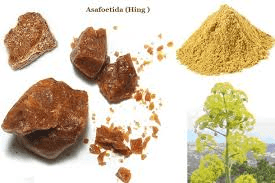Ferula Asafoetida is a resinous gum which is derived from the perennial fennel plant. Ferula Asafoetida can be used in a powdered form to relieve chest congestion and asthma, treat digestive issues like IBS, diarrhea, constipation and gassiness, regulate your blood sugar levels and lower your blood pressure. Asafoetida powder can also be added to soups and stews, or purchase it as a supplement in tincture or capsule form.
Ferula asafoetida is herbaceous plant of the umbelliferae family. It is oleo gum resin obtained from the rhizome and root of plant. This spice is used as a digestive aid, in food as a condiment and in pickles.
It is used in modern herbalism in the treatment of hysteria, some nervous conditions, bronchitis, asthma and whooping cough. It was at one time employed in the treatment of infantile pneumonia and flatulent colic.
The gum resin is antispasmodic, carminative, expectorant, laxative, and sedative. The volatile oil in the gum is eliminated through the lungs, making this an excellent treatment for asthma. The odor of asafoetida is imparted to the breath, secretions, flatus, and gastric eructations.
Its properties are antispasmodic, expectorant, stimulant, emmenagogue and vermifuge. Asafoetida has also been used as a sedative. It also thins the blood and lowers blood pressure.
It is widely used in India in food and as a medicine in Indian systems of medicine like ayurveda. Asafoetida has been held in great esteem among indigenous medicines, particularly in Unani system from the earliest times.
Ferula asafoetida Linn: Asafoetida, the gum resin prized as a condiment in India and Iran, is obtained chiefly from plant Ferula asafoetida. The Latin name ferula means “carrier” or “vehicle”. Asa is a latinized form of Farsi asa “resin”, and Latin foetidus means “smelling, fetid”. In ancient Rome, asafoetida was stored in jars together with pine nuts, which were alone used to flavor delicate dishes.
Another method is dissolving asafoetida in hot oil and adding the oil drop by drop to the food. If used with sufficient moderation, asafoetida enhances mushroom and vegetable dishes, but can also be used to give fried or barbecued meat a unique flavor. Ancient texts describe it as hingu and several centuries of its constant use have bestowed upon it the peculiarity of a tempting spice and trusted medicine.
Hing is bitter and pungent in taste and light, sharp, unctuous and hot in effect. Ayurvedic texts have categorized hing as deepniya and sanjna-sthapaka (an appetiser and a restorer of consciousness). It is popular household remedies and its components are used for many prescriptions in traditional healing.
Asafoetida is used as a flavoring agent and forms a constituent of many spice mixtures. It is used to flavor, curries, meatballs, dal and pickles. The whole plant is used as a fresh vegetable. The herb is also used as an antidote of opium. Given in the same quantity as opium ingested by the patient, it will counteract the effect of the drug.
As its name suggests, asafoetida has a fetid smell and a nauseating taste; characteristics that also burdened it with the name devil’s dung. In the middle Ages, a small piece of the gum was worn around the neck to ward off diseases such as colds and fevers. Whatever effectiveness it had was probably due to the antisocial properties of the amulet rather than any medicinal virtue.
Surprisingly, in Persia asafoetida was used as a condiment and called the “food of the gods”. This herb is the major component in the famous Ayurvedic herbal formula Hingashtak, Sanskrit name is hing. In Persia this herb is so highly esteemed as a condiment, it is mixed with almost all their dishes. French gastronomers rub a little asafoetida on hot plates from which they eat beef steaks.
The distinctive flavor of Worcestershire sauce is obtained by the addition of this gum. When used with discretion, it adds character to curries, stews, gravies, etc. Skilful manipulation has made asafoetida a useful ingredient in fine perfumes. It is still regarded a valuable medicinal in Europe, Near and far East.
As a condiment, it is recommended only to the hearty and the brave. In magic and mythology, asafoetida is used to gain insight and to banish all negative energy, evil spirits and demons. It is used to invoke male gods, especially those of a phallic nature. One myth claims that asafoetida developed from the semen of a god of fertility when it soaked into the earth.
Read Also: How to Grow Herbs and Spices in Urban Areas
Origin and Distribution
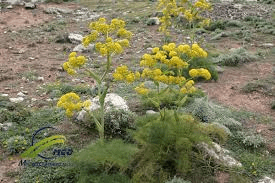
Ferula asafoetida is an herbaceous, monoecious, perennial plant of the UMBELLIFERAE family. Asafoetida is native to central Asia, eastern Iran to Afghanistan, and today it is grown chiefly in Iran and Afghanistan, from where it is exported to the rest of the world. It is not native to India, but has been used in Indian medicine and cookery for ages.
Other Names: Anghuzeh (Farsi); asafétida (Spanish); asafoetida; awei (Chinese); aza(Greek); devil’s dung; férule persique or merde dudiable (French); haltit or tyib (Arabic); hing (Hindi); mvuje (Swahili); stinkasant or teufelsdreck (German); stinking gum.
Asafoetida is extracted from the Ferula plants which have massive taproots or carrot-shaped roots, 12.5-15 cm in diameter at the crown when they are 4-5 years old. Just before the plants flower, in March-April, the upper part of the living rhizome root is laid bare and the stem cut off close to the crown.
A dome-shaped structure made of twigs and earth covers the exposed surface. A milky juice exudes from the cut surface. After some days, the exudates are scraped off and a fresh slice of the root cut when more latex exudes; sometimes the resin is removed along with the slice.
The collection of resin and slicing of the root are repeated until exudation ceases (about 3 months after the first cut). The resin is sometimes collected from successive incisions made at the junction of the stem or rhizome and the taproots.
Traditional Medicinal Uses
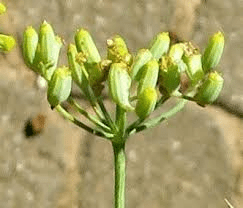
In Afghanistan hot water extract of the dried gum is taken orally for hysteria and whooping cough and to treat ulcers. Decoction of the plant is taken orally as a vermifuge in China.
Hot water extract of the dried root is taken orally as an antispasmodic, a diuretic, a vermifuge and an analgesic in Egypt. Gum is chewed for amenorrhea in Malaysia and as antiepileptic in Morocco.
Water extract of the resin in Nepal is taken orally as an anthelmintic and in Saudi Arabia dried gum is used medicinally for whooping cough, asthma, and bronchitis. In Brazil hot water extract of the dried leaf and stem is taken orally by males as an aphrodisiac and oleoresin powder, crushed with the fingertips, is used as a condiment.
Fluid extract of the resin is taken orally as an emmenagogue, a stimulating expectorant, an anthelmintic, an aphrodisiac, and a stimulant to the brain and nerves and claimed to be a powerful antispasmodic in United State.
Ferula Asafoetida as traditional medicine in India
Asafoetida has been held in great esteem among indigenous medicines from the earliest times in India. It is reputed as a drug which expels wind from the stomach and counteracts any spasmodic disorders.
It is also a nervine stimulant, digestive agent and a sedative. A dry Lampyris noctiluca without head is mixed with 200–300 mg of Ferula and taken mornings and evenings for gallstones and kidney stones and potassium nitrate is added to the mixture for old stones.
Hot water extract of the dried resin is taken orally as an emmenagogue and hot water extract of the dried gum is taken orally as a carminative, an antispasmodic, and an expectorant in chronic bronchitis.
Dried extract with Brassica alba and rock salt is diluted with vinegar and taken orally as an abortifacient. Dried gum resin exudates are eaten to prevent guinea worm disease. Gum resin with salt and the bark juice of Moringa pterygosperma is used externally for stomachaches.
Chemical Constituent
An analysis of asafoetida shows it to consist of carbohydrates 67.8% per 100 gms, moisture 16.0%, protein 4.0%, fat 1.1%, minerals 7.0% and fiber 4.1%.
Its mineral and vitamin contents include substantial calcium besides phosphorus, iron, carotene, riboflavin and niacin.
Its calorific value is 297, contains 40-64% resinous material composed of ferulic acid, umbel-liferone, asaresinotannols, farnesiferols A, B, and C etc., about 25% gum composed of glucose, galactose, l-arabinose, rhamnose, and glucuronic acid and volatile oil (3-17%) consisting of disulfides as its major components, notably 2-butyl propenyl disulfide (E- and Z-isomers), with monoterpenes (α- and β-pinene, etc.), free ferulic acid, valeric acid, and traces of vanillin (LAF).
The disagreeable odor of the oil is reported to be due mainly to the disulphide C11H20S2.
Read Also: Anise (Pimpinella Anisum): Importance and Health Benefits
Pharmacological Activities and Clinical Trials
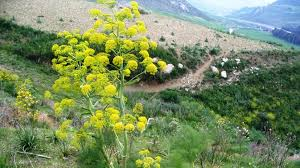
1. Effect of Ferula Asafoetida on Gastro Intestinal Tract
The herb is an effective remedy for several diseases of the stomach. It is one of the best remedies available for flatulence and is an essential ingredient for most of the digestive powders. In case of flatulence and distension of the stomach, Asafoetida should be dissolved in hot water and a pad of cloth steeped in it may be used for fomenting the abdomen.
Colloidal solution, administered orally to rats at a dose of 50 mg/kg, 60 minutes before experiment, produced significant protection against gastric ulcers induced by 2 hours cold-restraint stress, aspirin, and 4 hours pylorus ligation.
Gum extract, administered to isolated guinea pig ileum at a dose of 3 mg/mL, produced a decrease of spontaneous contraction to 54 ± 7% of control. Exposure of precontracted ileum by acetylcholine, histamine, and KCl to Ferula gum extract produced a concentration-dependent relaxation.
Preincubation with indomethacin, propanolol, atropine and chlorpheniramine before exposure to the gum, did not produce any relaxation. Asafoetida, administered orally to rats at a dose of 2500 mg% for 8 weeks, decreased the levels of phosphatases and sucrase in the small intestine.
Powder of the dried entire plant, administered by gastric intubation to adults at a dose of 0.2 g for 1 hour, was active. Asafoetida, administered orally to albino rats at a dose of 250 mg% for 8 weeks, enhanced pancreatic lipase activity, stimulated pancreatic amylase and chymotrypsin.
The stimulatory influence was not observed when their intake was restricted to a single oral dose. Asafoetida did not affect the digestibility of protein in sorghum.
2. Ferula Asafoetida and Cancer
Ethanol (90%) extract of the dried plant, in cell culture administered at a concentration 0.25 mg/mL, was active on human lymphocytes. The extract was active on Vero cells, effective dose (ED50 0.15 mg/mL; Chinese hamster ovary (CHO) cells, ED50 0.575 mg/mL; and Dalton’s lymphoma, ED50 0.6 mg/mL.
Water extract of the dried gum, in cell culture at a concentration of 500 μg/mL, produced weak activity on CA-mammarymicroalveolar cells. Water extract of the dried oleoresin, administered by gastric intubation to mice at a dose of 50 mg/animal daily for 5 days, was active on CAEhrlich ascites, 53% increase in life span (ILS). Water extract administered intraperitoneally was inactive on Dalton’s lymphoma, 4.8% ILS, and CA-Ehrlich ascites, 5.5% ILS.
Dried resin, administered orally to Sprague–Dawley rats at doses of 1.25 and 2.5% w/w of the diet, produced a significant reduction in the multiplicity and size of palpable N-methyl-N-nitrosourea-induced mammary tumors, and a delay in mean latency period of tumor appearance.
Oral administration to mice increased the percentage of life span by 52.9%. Intraperitoneal administration did not produce any significant reduction in tumor growth. The extract also inhibited a two-stage chemical carcinogenesis induced by 7,12-dimethylbenzathracene and croton oil on mice skin with significant reduction in papilloma formation.
Sodium ferulate, administered to human lymphocytes cell culture, induced apoptosis. Gum, administered to mice at a dose of 40 mg/g of diet, was active. The dose was inactive vs 3′-methyl- 4 dimethylaminoazobenzene-induced carcinogenesis.
Water extract of the dried oleoresin, administered externally to mice at a dose of 200 μL/animal, was active vs 7,12-dimethylbenz[a]anthracene and croton oil treatment.
Read Also: Arrowroot (Maranta arundinacea. L): Importance and Health Benefits
3. Ferula Asafoetida as Women’s Ailments
The herb is considered useful in the treatment of several problems concerning women such as sterility, unwanted abortion, pre-mature labor, unusually painful, difficult and excessive menstruation and leucorrhoea.
About 12 centigrams of gum fried in ghee mixed with 120 grams of goat’s fresh milk and a tablespoon of honey, should be given thrice daily for a month. It excites the secretion of progesterone hormone. Asafoetida is also useful for women after childbirth.
Owing to its antiflatulent and digestive properties, the herb can be taken with beneficial results during the post-delivery period. In southern India, the powder of the herb mixed with rice is given to women after delivery.
Methanol extract of the resin, administered orally to Sprague–Dawley rats at a dose of 400 mg/kg daily for 10 days, prevented pregnancy in 80% of the rats.
When administered as a polyvinylpyrrolidone 1:2 complex, 100% pregnancy inhibition was observed at this dose. Lower doses of the extract produced a marked reduction in the mean number of implantations.
Significant activity was observed in the hexane and chloroform eluents of sulfur-containing extract in an immature rat bioassay, the methanol extract was devoid of any estrogenic activity.
A mixture of Embella ribes fruit, Piper longum fruit, borax, Ferula-dried gum, Piper betle, Polianthes tuberosa, and Abrus precatorius, administered orally to female adults at a dose of 0.28 g/person starting from the second day of menstruation twice daily for 20 days, without sexual intercourse during the dosing period, produced the effect for 4 months and the activity was patented for both small and long term effects.
Hot water extract of the plant, administered to female rats, was inactive on estrogen of uterus. Extract administered to pregnant rats, was inactive on uterus.
4. Ferula Asafoetida and Gene Expression
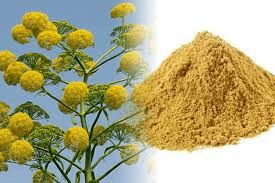
Asafoetida, administered orally to Sprague–Dawley rats at doses of 1.25% and 2.5% w/w, significantly restored the level of antioxidant system, depleted by N-methyl-N-nitrosourea treatment. There was a significant inhibition in lipid peroxidation as measured by thiobarbituric acid-reactive substances in the liver of rats.
Ethanol (95%) extract of the dried resin, on agar plate at a concentration of 15 mg/plate, produced weak activity on streptomycin-dependent strains of Salmonella typhimurium TA98. Metabolic activation has no effect on the result.
Resin, on agar plate at a concentration of 200 μg/plate, was active on S. typhimurium TA1537 and inactive on S. typhimurium TA1538 and S. typhimurium TA98. Gum, administered by gastric intubation to mice at a dose of 1 g/kg, was active.
The results were significant at p less than 0.01 level. A dose of 0.5 g/kg, produced weak activity. Asafoetida, administered orally to mice, produced weak activity in spermatogonia.
Water extract of the dried gum, on agar plate at a concentration of 2 mg/plate, was inactive on S. typhimurium TA100 vs aflatoxin B1-induced mutagenesis and a concentration of 10 mg/plate, was inactive on S. typhimurium TA98.
Asafoetida, on agar plate, was active on S. typhimurium TA100 and TA1535 microsomal activation-dependent mutagenicity of 2-acetamidofluorene.
5. Ferula Asafoetida and its effect on Blood Pressure
In one study tincture of the gland, administered intravenously to rabbits, produced significant hypotensive effects. Water extract of the dried gum resin, administered intravenously to dogs at variable doses, shown antihypertensive activity.
Gum extract, administered to anesthetized rats at doses of 0.3–2.2 mg/100 g body weight, and significantly reduced the mean arterial blood pressure.
6. Effect of Ferula Asafoetida on Blood Vessels and Blood
Water extract of the dried gum resin, administered to frogs, was active on the vein and shown vasodilatation effect. Tincture of the gland, administered to rabbits, was active on the bladder and intestine and produced significant smooth muscle relaxant effect, which may be helpful in lowering the blood pressure.
Water extracts of the gum, administered intravenously to dogs and rats at variable doses, shown anticoagulant activity. Ether extracts of the dried gum and gum resin, administered orally to 10 healthy subjects fed 100 g of butter to produce alimentary hyperlipemia, were actively shown fibrinolytic activity.
7. Ferula Asafoetida and Chemoprotective Therapy
Dried gum resin, on agar plate, was active on Clostridium perfringens and Clostridium sporogenes.
Essential oil of rhizome, on agar plate at a concentration of 400 ppm, was active on Microsporum gypseum and Trichophyton rubrum, and produced weak activity on Trichophyton equinumi.
Extract of asafoetida, on agar plate at concentrations of 5–10 mg/ mL, inhibited Aspergillus parasiticus aflatoxin production.
Ethanolic (95%) extract of the dried gum on agar plate showed antifungal activity. Oleo-gum resin from roots and stems was active on Trichomonas vaginalis. Asafoetida treatment significantly reduced the levels of cytochrome P450 and b5.
There was an enhancement in the activities of glutathione-S-transferase, deoxythymidine- diaphorase, superoxide desmutase, catalase, and reduced glutathione.
Asafoetida, administered orally to Sprague–Dawley rats at doses of 1.25% and 2.5% w/w in diet, produced an increase in the development and differentiation of ducts/ductules and lobules and a decrease in terminal end buds as compared to both normal and N-methyl-N-nitrosourea-treated control animals.
8. Ferula Asafoetida and Hypersensitivity Reactions
Allergenic activity was shown when oleoresin powder, administered externally to adults. Reactions to patch test occurred most commonly in patients who were regularly exposed to the substance, or who already had dermatitis on the fingertips.
Ethanolic (95%) extract of the resin, administered orally to two groups of 50 patients with irritable colon, shown anti-inflammatory. Results were significant at P < 0.001 level.
Read Also: Annatto (Bixa orellana L.): Importance and Health Benefits
9. Effect of Ferula Asafoetida on Lipid Profile
Resin, administered to rats fed an atherogenic diet, at a dose of 1.5%, failed to reduce the serum cholesterol levels. Gum, administered to female rats at a concentration of 1% of diet, not shown any antihypercholesterolemic activity.
A hot mixture of Nigella sativa, Commiphora myrrha, Ferula asafoetida, Aloe vera, and Boswellia serrata, administered by gastric intubation to rats at a dose of 0.5 g/kg for 7 days, was active vs streptozotocin-induced hyperglycemia.
10. Hepatoprotective effect of Ferula Asafoetida
A mixture of the methanol-insoluble fraction of the dried resin, fresh garlic, curcumin, ellagic acid, butylated hydroxytoluene, and butylated hydroxyanisole, administered by gastric intubation to ducklings at a dose of 10 mg/animal, shown antihepatotoxic activity vs aflatoxin B1-induced hepatotoxicity. Oleoresin, administered to rats at a dose of 250 mg%, shown hepatic oxidase inhibition.
11. Effect on CNS and Heart of Ferula Asafoetida
Ethanol extract of the dried gum, administered orally to adults at a dose of 20 mL/person, was active in CNS. Tincture of the gland, administered by perfusion to rabbits, produced weak activity on the heart.
12. Effect of Ferula asafoetida in Blood Sugar Level
A hot mixture of Nigella sativa, Commiphora myrrha, Ferula asafoetida, Aloe vera, and Boswellia serrata, administered by gastric intubation to rats at a dose of 0.5 g/kg for 7 days, was active vs streptozotocin-induced hyperglycemia.
Hot water extract of the dried gum, Nigella sativa, Myrrhis odorata, and Aloe sp. in equal parts, administered by gastric intubation to rats at a dose of 10 mL/kg for 7 days, was active vs streptozotocin-induced hyperglycemia. Results were significant at P < 0.05 level.
13. Antioxidant activity of Ferula Asafoetida
Asafoetida, administered orally to Sprague–Dawley rats at doses of 1.25% and 2.5% w/w, significantly restored the level of antioxidant system, depleted by N-methyl-N-nitrosourea treatment. There was a significant inhibition in lipid peroxidation as measured by thiobarbituric acid-reactive substances in the liver of rats.
14. Toxic Effect
Methemoglobinemia occurred in a 5-week-old infant after treatment with a gum asafoetida formulation to alleviate colic. Asafoetida may enhance the activity of warfarin.
A weak sister chromatid exchange-inducing effect in mouse spermatogonia and clastogenicity in mouse spermatocytes has been documented for asafoetida. Chromosomal damage by asafoetida has been associated with the coumarin constituents.
In conclusion, Asafoetida is an oleo-gum-resin obtained from the exudates of the roots of the Iranian endemic medicinal plant, F. asafoetida. It is used widely all over the world as a flavoring spice in a variety of foods.
Traditionally it is used for the treatment of various diseases, such as asthma, epilepsy, stomach-ache, flatulence, intestinal parasites, weak digestion and influenza.
Recent studies including pharmacological and biological have also shown that asafoetida possess several activities, such as antioxidant, antiviral, antifungal, cancer chemopreventive, antidiabetic, antispasmodic, hypotensive and molluscicidal. Asafoetida has great medicinal importance, detailed studies of asafoetida is required prior to clinical trial.
Read Also: How long does it take tilapia fish to grow?

